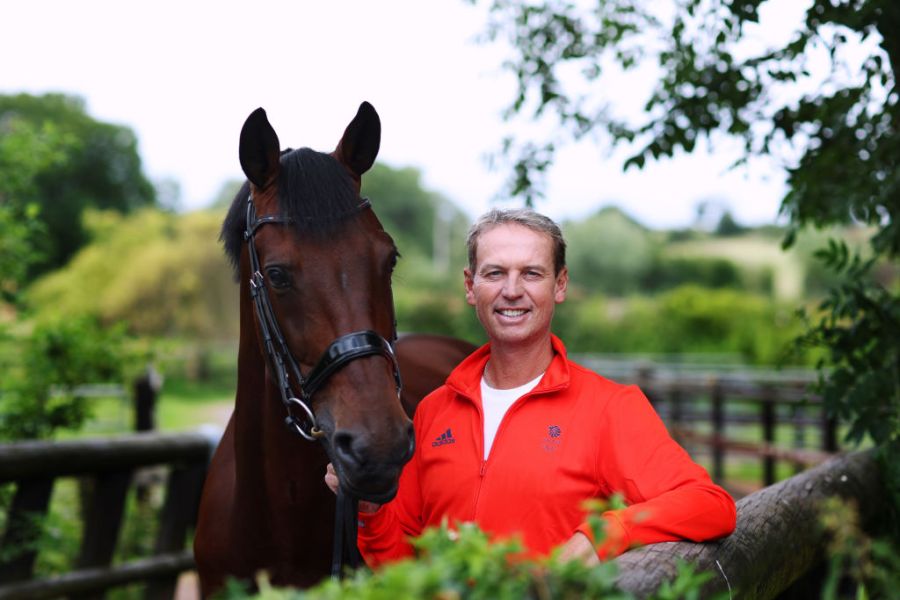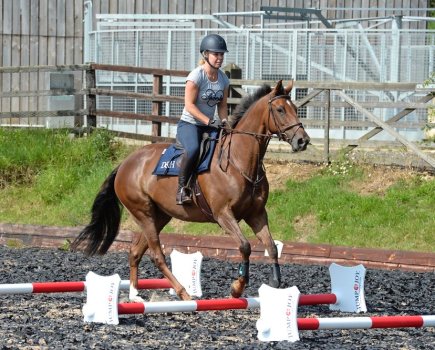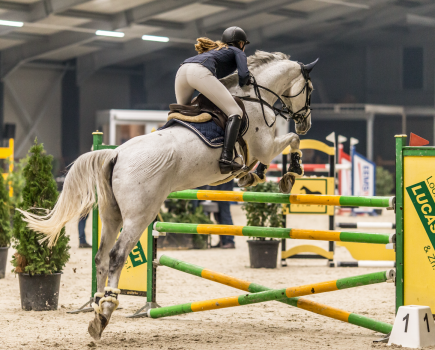Spectators at the Defender Burghley Horse Trials were treated to a masterclass with dressage legend Carl Hester on Friday lunchtime, who was fresh from his team silver medal-winning performance at the recent European Dressage Championships.
From improving downwards transitions to nailing accurate half pass, avoiding the common error of shoulder-out and understanding why half halts are a bit like doing a hill start in a car, there was a lot for all levels of rider to watch, enjoy and learn from.
Fans were delighted to see Tom McEwen riding his now semi-retired Olympic partner Toledo De Kerser. “Doesn’t he look a million dollars,” remarks Carl of the now 18-year-old, whose last competitive outing was at Burghley in 2023.
Richard Davison rides his impressive 12-year-old grand prix horse ‘Intero’ in the second half of the demo to show the difference between eventing dressage and pure dressage.
“Dressage is dressage and it’s my job to try and explain it to you,” says Carl, who begins the demonstration by reviewing some of the movements from the CCI5* Eventing Dressage test that the riders had to tackle at Burghley.
These are the top seven take away notes to apply to your own riding.
1 Go forwards to slow down
The very first movement that the judge sees is the entry and halt.
Carl asked Tom to show the crowd a ‘bad’ centre line and transition, although Toledo was eager to impress and still produced a square halt.
By using more hand, at the second attempt Tom was able to demonstrate some of the common mistakes riders make when riding the downwards transition to halt.
“If you go too fast into the transition, you will see it becomes what we call ‘riding from the front’,” explains Carl. “The canter’s too fast, there’s no preparation.
“Because he [Tom] used his hand to make the halt instead of using his seat and his body, the horse fell on the hand.
“The horse actually stepped back into the halt, which is a major fault.”
Carl said that even though the transition is a downwards one, the horse must always step forward into it.
2 It’s easier to straighten a horse on the left rein
Carl alludes to his experience at the recent European Dressage Championships, stating that riders were asked which rein they prefer to enter the arena on.
“Nearly 90% of the riders said that they enter on the left rein. That’s because it’s much easier for us as riders to straighten a horse on the left-hand side than the right,” he states.
Carl asks Tom to demonstrate his point by showing the extended canter on the long side.
He says that when you watch a horse do extended canter on the right rein, you will often see the right hindlegs more to the inside.
3 Size and expressions counts in the changes
Tom and Toledo show the crowd how to ride flying changes by riding them on the short diagonal.
Carl explains that for judges, as well as considering the correctness and straightness of the change, they also have to look at the size and expression of the change.
“If you took a picture of Tom doing his flying change, you would be able to see that Toledo’s hindleg comes high off the floor,” says Carl.
He notes that it is important to watch how Tom uses his leg aids during the changes.
“When he’s changing from the left to the right, his left leg will move slightly back and his right leg will come forward, which allows the horse to jump onto the new leg,” explains Carl.
4 Look through your horse’s ears in half pass
In the CCI5* test, half passes are ridden in both trot and canter on each rein. Carl shares his top tips for riding accurate lines.
“When you’re riding at a marker, you want to think can you look through your horses’ ears at the marker that you are riding at,” he says.
As Tom and Toledo execute a fluent canter half pass to the right, Carl describes how a rider needs to use their weight aids.
“In the right half pass the rider also has to sit to the right, use your weight aid which means pressing more on your inside stirrup.”
5 Quarters out is a common error
Carl says that one of the harder movements in the Burghley test is the trot shoulder-in on the centre line.
“One of the most common mistakes you will see is not shoulder-in but quarters out,” he says.
Tom rides the movement by pushing Toledo’s hindlegs over to illustrate Carls’s point, before producing a textbook shoulder-in next time round.
Carl explains that, when viewing a shoulder-in from the front, the horse should appear as if they are travelling on three tracks. “If you can see four tracks, that’s more of a leg yield down the centre line.”
Using the shoulder-in as an example, Carl describes how each movement should be ridden in parts: “Every movement has a start, a middle and a finish.
“The start is how you turn onto the centre line; the middle is containing the same angle and rhythm the whole way down; the finish is taking the shoulders back to the centre line, straightening up and then doing a really nice corner.”
6 Canter pirouettes are worth double marks
Richard Davison’s stunning grand prix horse ‘Intero’ wows the crowd by showing some of the higher-level movements in pure dressage.
Carl explains how a grand prix horse has to be able to sit and push, while Richard rides some piaffe and passage before demonstrating more collected work in canter.
Richard also rides some canter pirouettes, with Carl pointing out that horses are allowed to do six to eight steps in the movement, and that it has a double coefficient, which means double marks.
Next, Richard rides through some three- and two-time tempi changes. This means the horse changes lead in canter every third or second stride, without breaking the canter.
Some horses find flying changes very difficult, explains Carl, and it could take anywhere up to three years to learn a single flying change. “It’s not uncommon,” he says.
“Once they have got the hang of the single flying change, then the tempi changes tend to come a lot quicker.”
7 Halt halts are like a hill start
Before the session ends, Richard and Carl both speak about the importance of the half halt in all levels of dressage.
“The half halt is a mixture of the body, the leg and the rein. It’s a bit like doing a hill start with a manual car – you’ve got to combine the clutch, the handbrake and the accelerator,” says Richard.
Carl reiterates the importance of the way a rider uses their body in the half halt.
“A half halt is a rebalancing of the horse. Think that the front of your body comes longer when you make a half halt, you don’t collapse over the front of the horse.”
Main image of Carl and Fame by Dan Istitene/Getty Images
Related content
- Richard Davison dressage masterclass: why and how you should ride your horse in different outlines *video*
- Carl Hester leads Britain to team silver at the FEI European Dressage Championships
- Richard Davison dressage masterclass: why and how you should ride your horse in different outlines *video*
- Scales of Training in dressage and flatwork explained







